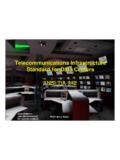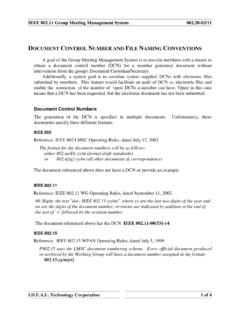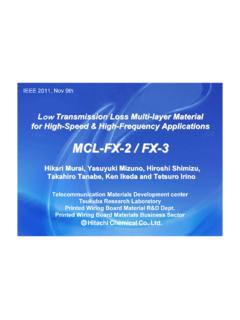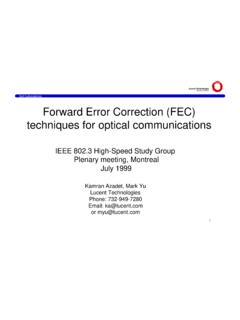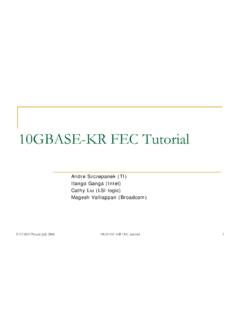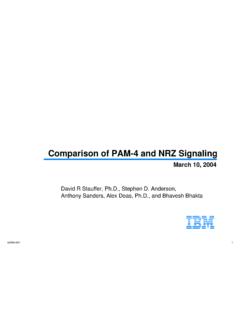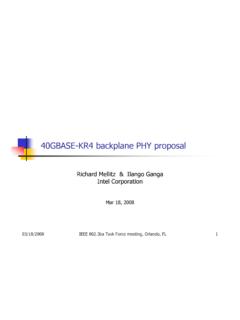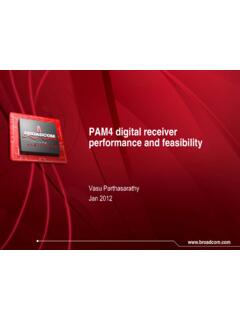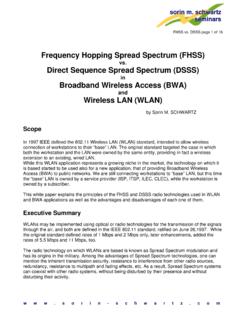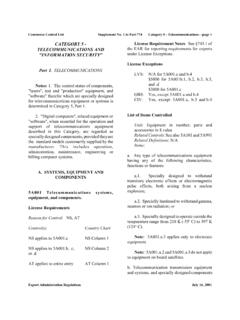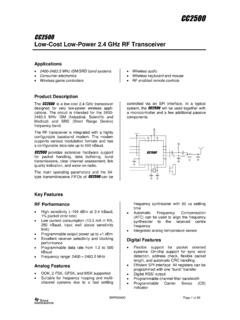Transcription of Comparison of QPSK/QAM OFDM and Spread Spectrum for …
1 2000-09-02 IEEE Broadband Wireless Access Working Group < >TitleComparison of QPSK/QAM ofdm and Spread Spectrum for the 2-11 GHz PMPBWASDateSubmitted2000-09-02 Source(s)Malcolm Sellars and Demos KostasAdaptive Broadband DartmouthDallas, TX 75205 Voice: 1 214 520 8411 Fax: 1 214 520 response to the Call For Contributions, by IEEE of the key characteristics of the is modulation. This contribution comparesthe advantages/disadvantages of Single Carrier QPSK/QAM , ofdm , or Spread Spectrumsignaling techniques for the 2 to 11 GHz bands PMP Fixed Broadband Wireless Access Systems.
2 And based on this analysis and actual experience with PMP Fixed BWAS bands proposes thatQPSK/QAM be used in the proposed Task Group 3 should specify that Single Carrier QPSK/QAM be used for the Standard as is currently specified for the ETSI BRAN HiperaccessNoticeThis document has been prepared to assist IEEE It is offered as a basis for discussion and is not binding onthe contributing individual(s) or organization(s). The material in this document is subject to change in form andcontent after further study. The contributor(s) reserve(s) the right to add, amend or withdraw material contributor grants a free, irrevocable license to the IEEE to incorporate text contained in this contribution, andany modifications thereof, in the creation of an IEEE Standards publication; to copyright in the IEEE s name anyIEEE Standards publication even though it may include portions of this contribution; and at the IEEE s solediscretion to permit others to reproduce in whole or in part the resulting IEEE Standards publication.
3 Thecontributor also acknowledges and accepts that this contribution may be made public by IEEE PolicyandProceduresThe contributor is familiar with the IEEE Patent Policy and Procedures (Version )< >, including the statement IEEE standards may include the knownuse of patent(s), including patent applications, if there is technical justification in the opinion of the standards-developing committee and provided the IEEE receives assurance from the patent holder that it will license applicantsunder reasonable terms and conditions for the purpose of implementing the standard.
4 Early disclosure to the Working Group of patent information that might be relevant to the standard is essential toreduce the possibility for delays in the development process and increase the likelihood that the draft publication willbe approved for publication. Please notify the Chair as early as possible, in written orelectronic form, of any patents (granted or under application) that may cover technology that is under considerationby or has been approved by IEEE The Chair will disclose this notification via the IEEE web site< >.2000-09-02 IEEE 1 Comparison of QPSK/QAM , ofdm , and Spread Spectrum for 5 GHzPMP BWASM alcom Sellars and Demos KostasAdaptive Broadband of the key characteristics of the is modulation.
5 This paper presents a Comparison of threemodulation choices for broadband wireless access systems: single-carrier QPSK/QAM , ofdm and QPSK/QAMS ingle-carrier QPSK/QAM is proven technology. Time-division systems (as opposed to Spread Spectrum ) canprovide fast, dynamic capacity allocation, which is ideal for statistical multiplexing of bursty sources [1]. Formany users, web-browsing demands high downstream data rates, and low upstream data rates (asymmetricalcapacity). However, small businesses may demand symmetrical capacity in both directions, or perhaps even ahigher upstream capacity for web-hosting.
6 This means that dynamic allocation of the downstream and upstreamcapacity is very problem with single-carrier systems is that in severe multipath channels, an adaptive equalizer is needed,requiring intensive processing at high data rates [2]. However, for line-of-sight (LOS) BWA systems withdirectional antennas, only a short equalizer of not more than 8 feedforward taps would be required. This isreasonably easy to achieve with current processors. Another problem with single carrier systems operating issusceptibility to interference. In order to solve this problem, some form of dynamic frequency selection (DFS)will be QPSK / QAMA dvantage sDi sadvantage bit rates, proventechnology, chosen and ETSI BRANH iperaccess1.
7 Susceptible to multipath interference (needs anequalizer)2. Efficient, dynamic capacityallocation for bursty Susceptible to interference (needs interferenceavoidance technique)2000-09-02 IEEE 2 OFDMO rthogonal frequency division multiplexing ( ofdm ) is a type of multicarrier modulation. ofdm uses overlappedorthogonal signals to divide a frequency-selective channel into a number of narrowband flat-fading of transmitting the data symbols sequentially at a high symbol rate on a single carrier, a block of symbolsis encoded using the Fast Fourier Transform (FFT), and transmitted in parallel over a number of subchannels.
8 Thesubchannels are spaced by the inverse of the symbol time, so making them orthogonal. Individual subchannelswill have a symbol period longer than the multipath delay Spread , and so ofdm is useful for avoiding multipathinterference. If a particular subchannel has high noise or interference, then it can be deactivated, so reducing theeffects of fading and technology is still under development, and there are a number of problems to be solved. Firstly, the guardbands and cyclic prefix reduce data throughput. Frequency offsets between transmitter and receiver must beremoved with automatic frequency control (AFC), otherwise the subcarriers will no longer be of multicarrier schemes is more difficult than single carrier because there may be hundreds ofsamples per multicarrier symbol.
9 Finally, because there are a large number of subcarriers, the combined signal hasa very large peak-to-average power ratio (PAPR), and to maintain linearity over this range, the power amplifier(PA) requires back-off by as much as 10dB. ofdm is very attractive for mobile radio transmission wheremultipath interference is severe. It is shown in [3], [4] that the BER performance of an ofdm system is verysimilar to that of a single-carrier system. ofdm performance can be improved through the use of channel codingand PAPR reduction techniques (although this introduces more complexity).
10 OFDMA dvantage sDi sadvantage s1. Mitigates multipath1. High complexity and deployment costs2. Guard bands reduce efficiency3. Frequency offsets require accurate AFC4. Synchronization is difficult5. High peak-to-average power ratio requiresPA back-off2000-09-02 IEEE 3 Spread SpectrumSpread Spectrum is divided into 2 groups: frequency hopping Spread Spectrum (FHSS), and direct sequencespread Spectrum (DSSS) (also known as CDMA). Spread Spectrum (both FHSS and DSSS) is proposed (b), for bit rates up to 11 Mbps.
